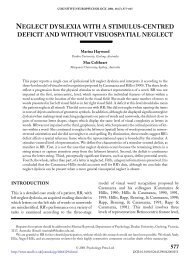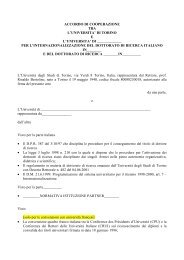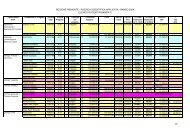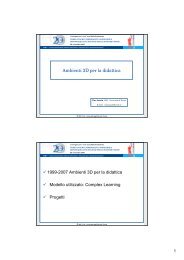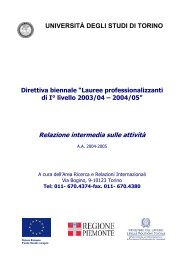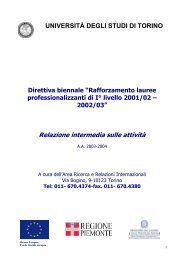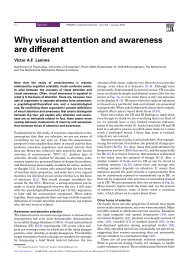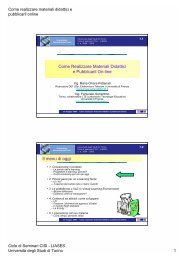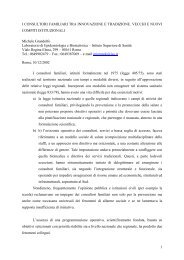Spatial hemineglect in humans - Cisi
Spatial hemineglect in humans - Cisi
Spatial hemineglect in humans - Cisi
You also want an ePaper? Increase the reach of your titles
YUMPU automatically turns print PDFs into web optimized ePapers that Google loves.
G. Kerkho€ / Progress <strong>in</strong> Neurobiology 63 (2001) 1±27 15<br />
tional, representational, transformational, and cerebral<br />
balance theories (cf. Table 5).<br />
13.2. Attentional theories<br />
Accord<strong>in</strong>g to the orient<strong>in</strong>g vector model, proposed<br />
by K<strong>in</strong>sbourne (K<strong>in</strong>sbourne, 1987, 1993), both hemispheres<br />
conta<strong>in</strong> a k<strong>in</strong>d of orient<strong>in</strong>g vector that directs<br />
attention to the contralateral hemispace. These orient<strong>in</strong>g<br />
tendencies are not only active <strong>in</strong> the exploration of<br />
external space but also of <strong>in</strong>ternal spatial representations<br />
(K<strong>in</strong>sbourne, 1993). Lesion to this putative vector<br />
<strong>in</strong> the right hemisphere therefore leads to a<br />
hypoexploration of the left hemispace and a hyperattention<br />
for stimuli located <strong>in</strong> the ipsilesional, right<br />
hemispace due to the <strong>in</strong>tact attentional vector <strong>in</strong> the<br />
healthy left hemisphere which operates <strong>in</strong> right hemispace.<br />
Accord<strong>in</strong>g to this theory, every unilateral hemispheric<br />
lesion should produce contralateral neglect Ð<br />
which obviously is not the case (see Section 2).<br />
Another critical po<strong>in</strong>t of the theory is that it fails to<br />
expla<strong>in</strong> why there is this strik<strong>in</strong>g hemispheric asymmetry<br />
<strong>in</strong> the frequency and severity of spatial <strong>hem<strong>in</strong>eglect</strong>.<br />
This would require the assumption of a stronger<br />
right-hemispheric attentional vector and a weaker lefthemisphere<br />
vector.<br />
This is exactly what two other theories of neglect by<br />
Heilman and coworkers (1995) and Mesulam (1998)<br />
have proposed. Heilman and Van Den Abell (1980)<br />
proposed some 20 years ago that the right hemisphere<br />
might be dom<strong>in</strong>ant for attention <strong>in</strong> both hemispaces<br />
while the left is only specialized for the right hemispace.<br />
Mesulam later restated this idea <strong>in</strong> anatomical<br />
terms. His theory states that the right hemisphere conta<strong>in</strong>s<br />
a neural network for directed visuo- or tactilespatial<br />
attention which is specialized for both the left<br />
and right hemispace, while the comparable system <strong>in</strong><br />
the left hemisphere subserves only the right hemispace.<br />
The neural network <strong>in</strong>cludes the lateral premotor cortex<br />
(frontal eye ®elds), posterior parietal cortex, c<strong>in</strong>gulate<br />
cortex and subcortically the basal ganglia and<br />
thalamus (Mesulam, 1998). While the more anterior<br />
areas <strong>in</strong> each hemisphere are relevant for shift<strong>in</strong>g the<br />
focus and guid<strong>in</strong>g exploration posterior areas <strong>in</strong> the<br />
parietal cortex deal with visual salience of stimuli <strong>in</strong><br />
external space (see Fig. 8A). Lesions to the right hemisphere<br />
would produce left neglect while left hemisphere<br />
lesions lead only rarely to contralesional neglect s<strong>in</strong>ce<br />
the stronger right-hemispheric attentional system may<br />
compensate for the de®cit as a result of its bilateral<br />
attentional focus. This model is supported by imag<strong>in</strong>g<br />
studies for tactile-spatial (Gitelman et al., 1996) and<br />
visuospatial attention (Nobre et al., 1997; Gitelman et<br />
al., 1999) <strong>in</strong> healthy subjects. In both studies, a stronger<br />
right parietal activation was found <strong>in</strong> most but not<br />
all subjects that would neatly expla<strong>in</strong> how right neglect<br />
may occur sometimes after leftsided lesions, but is<br />
nevertheless rare. Furthermore, the di€erent stations of<br />
Table 5<br />
Summary of current neglect theories (see text for further details)<br />
Attentional theories: Neglect is viewed as<br />
An exaggeration of the orient<strong>in</strong>g of attention towards the ipsilesional side (ipsilesional hyperattention, K<strong>in</strong>sbourne (1987).<br />
A de®cit <strong>in</strong> disengag<strong>in</strong>g attention from an ipsilesional focus towards a new stimulus on the contralesional side (Posner and Driver, 1992).<br />
As a result of damage to a neuronal network preferentially elaborated <strong>in</strong> the right hemisphere for the direct<strong>in</strong>g of attention towards the ipsiand<br />
contralesional hemispace (Heilman and Van Den Abell 1980; Nobre et al., 1997).<br />
The result of damage to a visual salience map located predom<strong>in</strong>antly <strong>in</strong> the human right hemisphere (Anderson, 1996).<br />
Representational theories<br />
Perception of sensory events requires their mental representation. Neglect results from an impairment <strong>in</strong> the representation of the contralesional<br />
space and body (Bisiach and Luzzatti 1978; Bisiach et al., 1981).<br />
Each hemisphere conta<strong>in</strong>s a topographically organized memory map of the contralateral visual world (Ga€an and Hornak, 1997), which is<br />
disrupted <strong>in</strong> neglect.<br />
Di€erent parts of extrapersonal and body space are motorically coded or represented by di€erent neural structures. A lesion of these<br />
structures causes contralesional neglect (Rizzolatti et al., 1997).<br />
Transformational theories<br />
Act<strong>in</strong>g <strong>in</strong> space requires a transformation of the various sensory <strong>in</strong>put <strong>in</strong>formations from sensory (visual, auditory, tactile, olfactory) <strong>in</strong>to<br />
motor coord<strong>in</strong>ates which operate <strong>in</strong> body-part-centered coord<strong>in</strong>ates (eye-,hand-, arm-, head-centered, Vallar, 1997; Karnath, 1997; Colby,<br />
1998). This coord<strong>in</strong>ate transformation is thought to be impaired <strong>in</strong> neglect.<br />
Cerebral balance theories<br />
Neglect studies <strong>in</strong> cats <strong>in</strong>dicate that is not the absolute level of neural activity with<strong>in</strong> each cerebral hemisphere that determ<strong>in</strong>es neglect but the<br />
relative (<strong>in</strong>)balance between cortical and subcortical structures <strong>in</strong> the lesioned and <strong>in</strong>tact hemisphere (Lomber and Payne, 1996; Payne et al.,<br />
1996). Complex, excitatory and <strong>in</strong>bibitory <strong>in</strong>teractions occur on a cortical and subcortial level between the lesioned and the nonlesioned<br />
hemisphere, probably via callosal ®bres (Payne et al., 1991).<br />
Dorsal versus ventral contributions to neglect<br />
Without <strong>in</strong>tend<strong>in</strong>g to o€er a complete model of neglect it is suggested (Milner, 1995, 1998) that neglect results from a dysfunction of the<br />
ventral stream while visuomotor functions are thought to be largely spared because of the <strong>in</strong>tegrity of the visuomotor functions <strong>in</strong> the dorsal<br />
stream.




